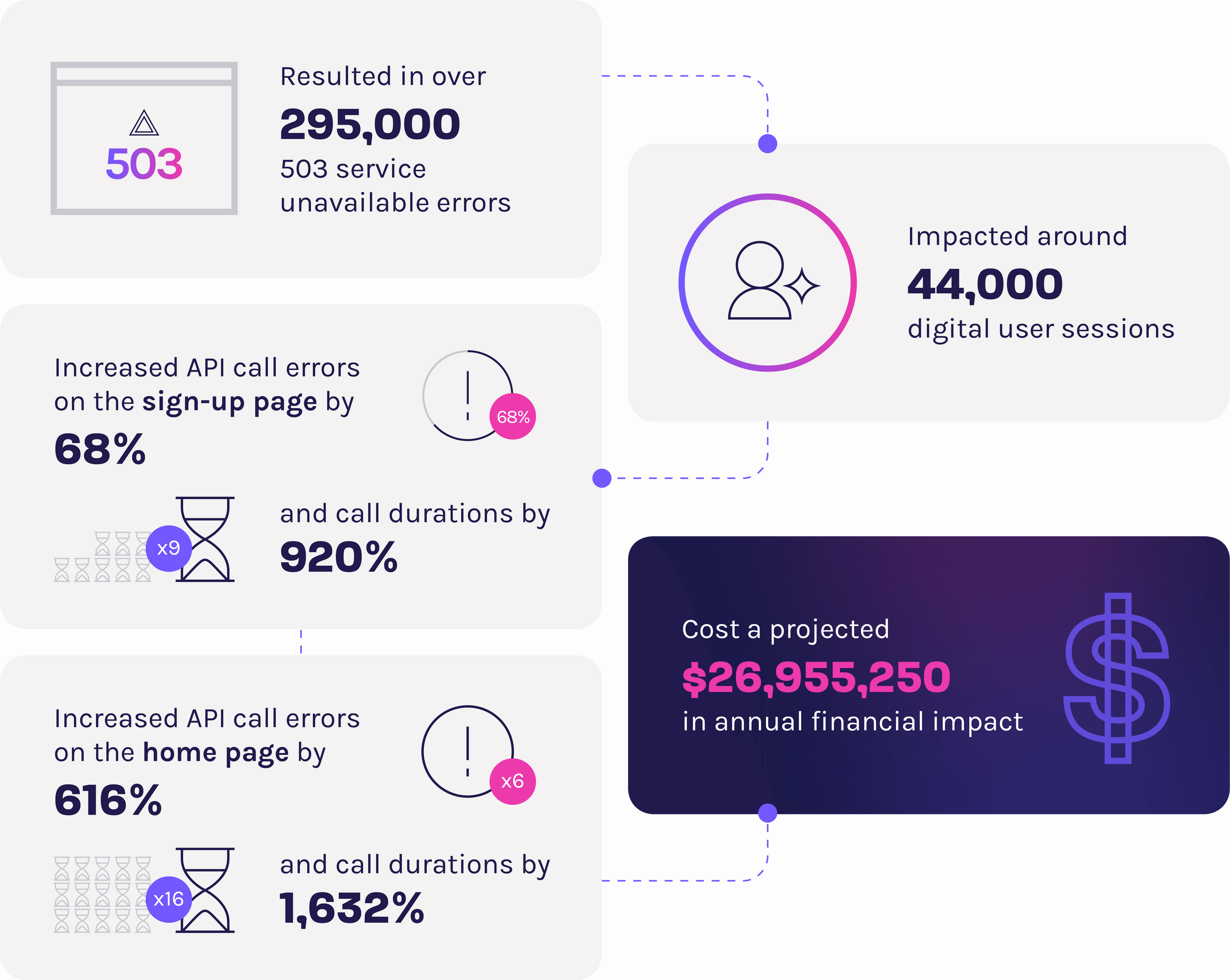
How To Recover Fast From Platform Outages
In a recent analysis of a major U.S. financial platform’s outage in October 2025, we saw just how quickly a small service disruption can escalate—causing over 295,000 errors across nearly 44,000 user sessions.
Moments like these highlight a hard truth: Outages happen to everyone, no matter how advanced the infrastructure or how many redundancies are in place. What separates resilient companies from reactive ones is how they understand and respond when systems fail.
For financial institutions, that response can make or break customer trust. Let’s look at what actually happens during an outage, what it costs and how teams can recover faster next time.
What Happens During an Outage
Most outages start quietly. An overloaded API stops responding. A downstream service times out. Soon, login and payment requests begin stacking up.
Within minutes, small disruptions turn into cascading errors. For instance, the analysis from earlier found the outage:

Clearly, even brief failures can ripple through the entire user journey. When customers can’t sign in, transfer funds or check balances, they refresh, retry or drop off.
The Real Impact: Customer Trust and Revenue Loss
Each abandoned session carries a cost—measurable in both dissatisfaction and disruption to the business. During the October outage, abandonment spiked up to over 31% within minutes as customers hit repeated login and home screen errors. Many tried multiple times before giving up, which only increased system load and delayed recovery.
For financial institutions, this behavior triggers a chain reaction:
Interrupted payment flows affect revenue recognition and reporting
Support queues grow, stretching internal resources
Compliance teams face pressure to document the disruption
Even short incidents can leave long shadows. So what can organizations do about an outage?
How To Respond to an Outage
When platforms fail, recovery depends on visibility, coordination and preparation. Here are five steps you can follow to limit damage and strengthen resilience:
1. Stabilize Your Systems
Start by checking infrastructure and application health dashboards to pinpoint what’s failing. Restart unhealthy instances before they cascade across services. Flush caches and DNS to remove stale or broken routes. Reduce non-critical workloads so your most important customer-facing systems get priority. Once core systems stabilize, verify that the root cause has been fully resolved before bringing all services back online. Premature restarts can trigger another wave of instability. The goal is to restore stability fast while minimizing downstream disruption.
2. Communicate Early and Transparently
Acknowledge the problem before your customers discover it on their own. Use banners or notifications to confirm that you’re aware of the issue and working on a fix. Offer alternate access options like phone banking or scheduled callbacks when possible. Internally, keep every team aligned so support, compliance and communications share the same facts. Clear, consistent communication builds trust and prevents a technical issue from becoming a brand crisis.
3. Ease the Pressure
During an outage, every unnecessary request adds pressure. Use circuit breakers to stop repeated failed calls and add retry logic with gradual backoff to keep systems from flooding. On the server side, use a caching layer like Redis or DynamoDB to absorb demand and reduce backend load. Even serving slightly stale data from a global cache keeps essential services running until systems stabilize. Smart load control helps the platform recover faster and protects the customer experience in the meantime.
4. Monitor in Real Time
You can’t fix what you can’t see. Real-time monitoring with session replay and synthetic testing helps you detect failing paths instantly. Prioritize fixes based on user impact, not just technical alerts. Watch metrics like abandonment rate, page load time and API error percentage to see where users feel the pain first. The sooner your teams see what customers see, the faster they can respond.
5. Build Smarter Resilience
Every outage is a lesson. After systems stabilize, run a post-incident review that connects system data with user behavior. Use digital experience intelligence (DXI) to replay actual customer sessions during the event. Identify where users dropped off, which APIs failed first and how recovery efforts affected the experience. Each incident becomes a blueprint for stronger architecture, smarter response playbooks and better resilience across the organization.
Resilience isn’t about avoiding outages, it’s about making sure the business keeps moving when they happen.
Turning Outages into Insight
Every failure contains valuable information. DXI tools like Glassbox help teams see what users experienced in the moment—where they clicked, what slowed down and what caused frustration.
By combining behavioral analytics with performance data, teams can connect what went wrong with how it felt to customers. This allows you to:
Correlate user frustration with spikes in error rates
Measure the true cost of downtime through session loss and conversion drop-off
Build data-driven cases for infrastructure investment and CX improvements
The goal isn’t just faster recovery. It’s continuous improvement through clear, user-centric visibility.
Get a demo to see how Glassbox helps financial organizations detect and recover from platform outages before customers notice.




